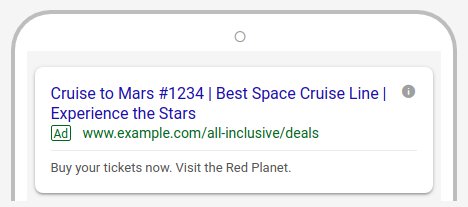Page Summary
-
Responsive search ads use multiple headlines and descriptions that rotate to find the best performing combinations.
-
You can pin specific headlines and descriptions to always appear in certain positions in the ad.
-
Performance statistics are collected on different combinations to optimize ad effectiveness.
-
The displayed URL can be customized using
path1andpath2fields.
Use responsive search ads to promote products on the Google Network. The main features of responsive search ads are that they let you:
- Set three or more headlines and two or more descriptions that will automatically rotate into the ad to determine which work best.
- Pin any headlines and descriptions you want so that they always appear in the ad.
- Collect performance statistics on different combinations of headlines and descriptions so you can determine their effectiveness. The system automatically favors headline and description combinations which work well together.
- Display customized URLs by specifying
path1andpath2, which are then appended to the end of your landing page domain to determine the displayed URL.
Format
Responsive search ads are displayed with three headlines and two descriptions
at serve time, plus a customizable URL based on the landing page domain and how
you've set up the path1 and path2 fields on your ad.
Here's an example of what an ad like this might look like, based on the example shown later in the guide:

Headlines and descriptions are represented as arrays of a resource called an
AdTextAsset.
Responsive search ads also support the new concept of pinning. If you want
finer control than simply allowing the system to mix and match headlines and
descriptions, you can pin headlines and descriptions to specific positions. For
example, if you want a specific headline to always show first, you can set that
AssetLink to have a pinnedField of HEADLINE_1. Then, whenever that ad is
served, that specific text will be in the first headline position and the other
fields will be drawn from the pool of remaining assets. If more than one asset
is pinned to a specific position, then that position will rotate text between
all assets that are pinned to that position.
Additional resources
To learn more about responsive search ads, check out the following Help Center articles.
